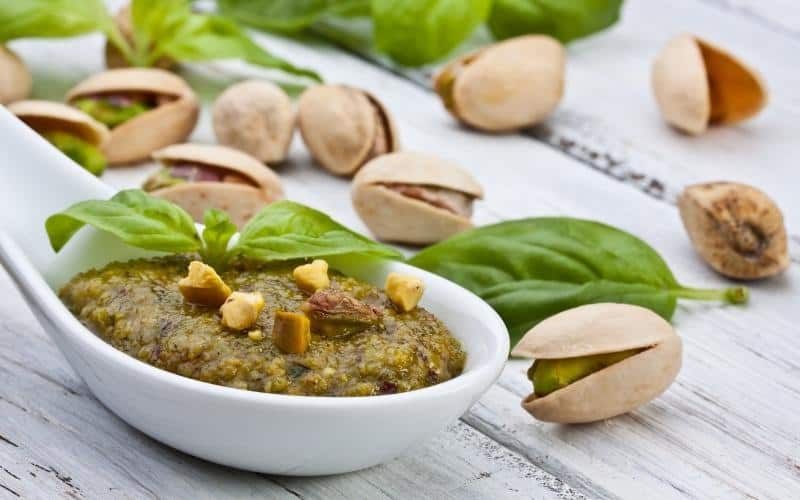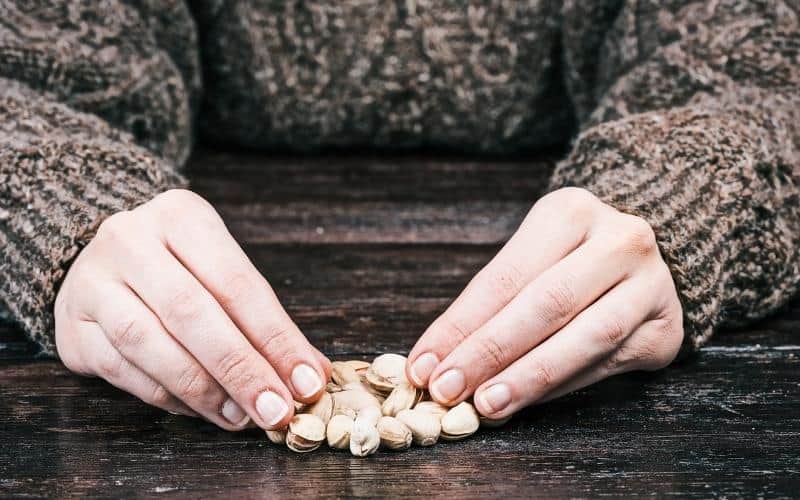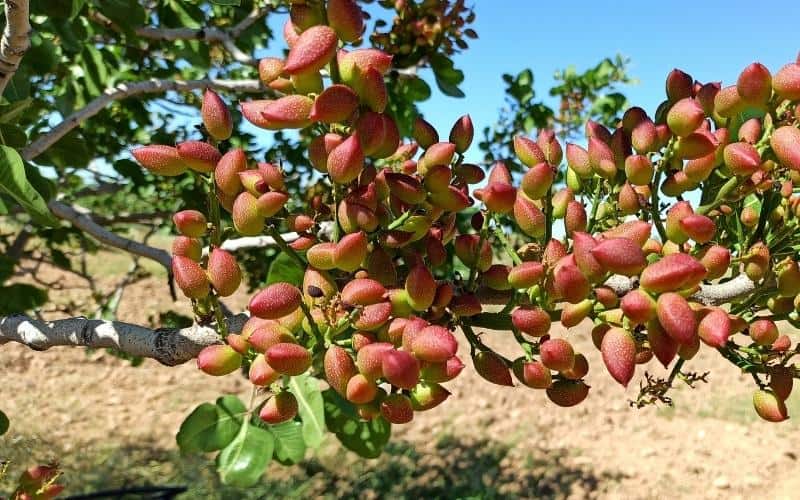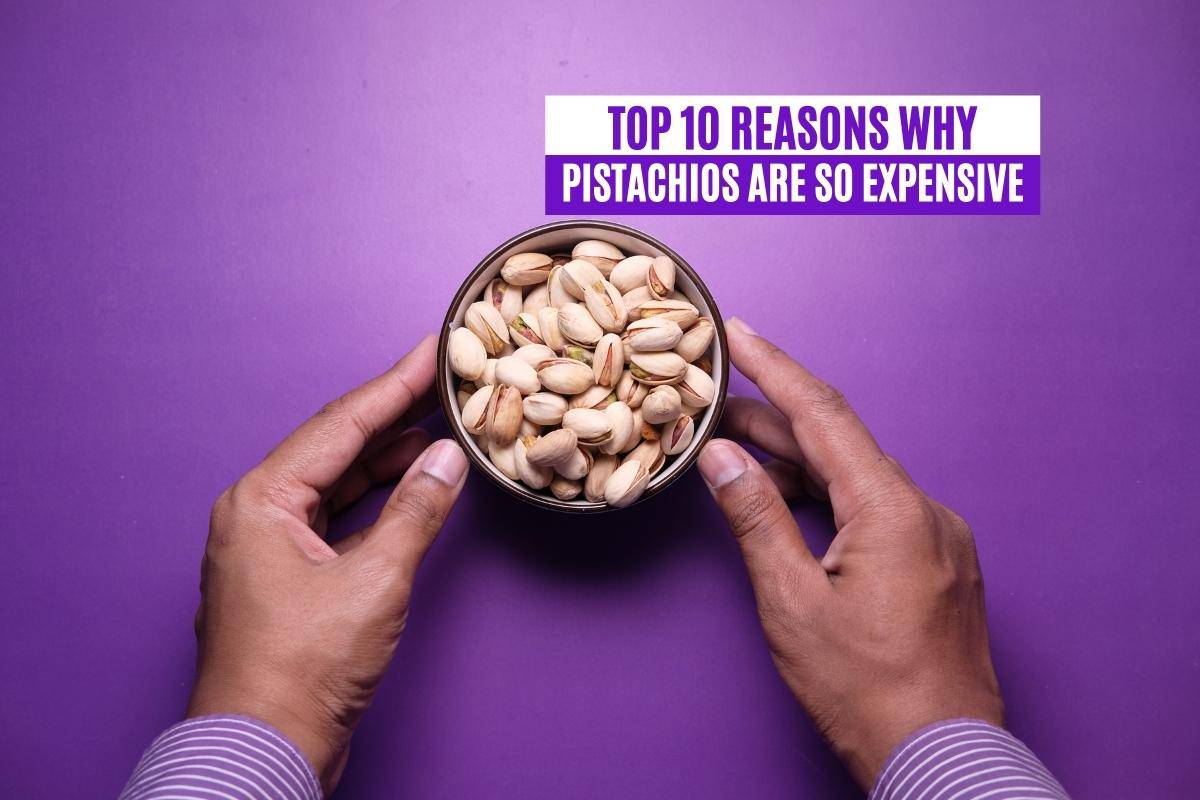From creamy, delicious ice cream to handmade Iranian baklava, you can’t go far before you are face to face with a pistachio. This green, oblong nut has become popular with dessert lovers and among health food enthusiasts. Somehow, they have united the whole world in adoration!
Everyone loves the humble pistachio, but why are pistachios so expensive?
As it turns out, the journey that single, tiny pistachio has to take spans decades! From picky climate conditions to complicated propagation methods, there is a lot of work involved in getting these salty snacks from the tree to the supermarket! The key to understanding pistachio cost is understanding everything that goes into farming, harvesting, sorting, packaging, and shipping these beloved treats.
Before you put that costly bag of pistachios back on the shelf and settle for peanuts, don’t you want to know what makes them worth the price?
We’ve gathered the top ten reasons why this little nut comes with that disproportionately big price tag! Keep reading to learn everything you need to know about the cost of satisfying your pistachio craving!
10. Culinary Use and Cultural Significance

The first and simplest reason why pistachios are so expensive is that people love them! They appear in both sweet and savory recipes in cultures throughout the world. Plus, they make a delightfully crunchy snack all on their own.
As it turns out, pistachios have a rather royal history! The Queen of Sheba made it illegal for commoners to grow the nut in the 10th century, decreeing it strictly for royalty. The King of Babylon, Nebuchadnezzar, grew pistachios for himself in his fabled hanging gardens.
Pistachios appear in recipes and cookbooks spanning back to Ancient Rome! They have the most cultural and historical significance in the Mediterranean, where the majority of them are grown.
The nuts quickly made their way to the rest of the world from there. They have tremendous nutritional value for their size, making them a perfect food for men on long trading journeys.
Because of its taste and nutrition, the pistachio became ideal for trade. In the ancient world, transporting goods was a lot more expensive and complex, however. Thus, pistachios have held a reputation as an expensive luxury food since the Middle Ages!
9. The “Health Tax” Drives up the Price
What is the “health tax?” Essentially, people are willing to pay a premium for healthier food. Since pistachios pack a hearty nutritional wallop, health nuts are willing to pay a whole lot more for these health nuts!
Pistachios aren’t a nut at all. They are the seed of the pistachio tree. The white outer “shell” is the hardened drupe, or fruiting body, of the pistachio tree.
As a result, pistachios have different nutritional qualities than your average nut, since they aren’t nuts at all. Straight off the tree, they contain zero cholesterol and zero sodium. A single ounce of unshelled pistachios contains almost six grams of protein and nearly three grams of fiber!
Although they are somewhat high in fat, that makes them more satiating. They have about 13 grams of fat per one-ounce serving.
They are full of vitamins and nutrients, too. No matter how you look at it, they’re a nutritionally dense, highly efficient food. As long as health-conscious folks are willing to shell out more, you will end up paying more to crack those shells!
8. Climate Change
Climate change is affecting the way that we experience seasons globally. It means hotter summers and colder, more brutal winters. This is even true in places without strict delineations between the seasons.
In the United States, there is only one state with a climate that is suitable for growing pistachio trees. Domestically, they are grown and harvested exclusively in California. With that perfect “goldilocks” climate shifting, The Golden State might not be the ideal home for our nation’s pistachio farms for much longer.
If pistachio trees experience even a single day of frost, it can have a major impact on their yield that season. Right now, farmers can compensate for these subtle changes, but it’s not cheap. Thus, the consumer sees this reflected in the high cost of the nuts.
7. Water Can Be Expensive
Pistachio trees are exceptionally thirsty plants! They need a lot of water to grow and thrive. A hot, rainy climate is ideal for these finicky trees, but what happens when these hot countries experience drought?
This is more common than you think. Outside of California, the majority of pistachios in the world come from the Middle East. Pistachio trees love sweltering, dry heat, but without enough rain, they cannot thrive.
This is fine when farmers can provide adequate water through irrigation systems and other means. When water becomes scarce, however, it also becomes expensive. Pistachio trees aren’t the only plants that need water, and pistachio farmers aren’t the only individuals impacted during a drought.
When even water becomes a scarce resource, the price goes up. The value of every single crop will rise to offset the additional expense of bringing in water. Pistachios, which are already quite expensive, are no exception.
The less rain we get, the more expensive pistachios become. This is only exacerbated by reason #8, climate change.
6. Farming Pistachios Requires Hands-on Labor
Pistachio trees are very needy plants. In addition to their temperature and water requirements, a lot of the labor involved in farming them is hands-on. In a large pistachio orchard, it takes a lot of manpower to tend to the many trees before harvesting time.
Often, you need to hand water each tree. They may also need to be specially pruned throughout the season. When the trees finally do bear mature fruit, every pistachio is will be hand-picked by a laborer.
Every individual who interacts with these trees must be paid. Plus, farmers are responsible for payroll taxes, and even workers comp. With employees constantly on ladders and operating heavy machinery, insurance is not optional!
In the United States, recent labor reform means that many farmers are being pressured to pay higher wages. When growing a plant is already time-consuming, these labor costs will add up! When you buy California-grown pistachios at the store, part of that money goes to paying a living wage to those hard-working farm laborers!
5. Laborers Hand Sort the Pistachios

Even after farmers harvest their pistachios, there is still a lot of work to do! Worldwide, pistachios are still traditionally sorted by hand. This ensures that the highest quality pistachios make it to store shelves, while lower quality pistachios are not wasted.
Laborers who do this sorting must make quick decisions. The longer the sorting process takes, the more money the process will cost the farmer.
The lower-quality pistachios often end up getting sold to manufacturers who crush them up to create their products. This is why pistachio ice cream will cost you about the same price as chocolate chip.
As prices rise, you might want to take a look at the nutrition label on the back of your tub of pistachio ice cream – many manufacturers are cutting costs by using artificial flavoring and less expensive nuts!
And those high-quality pistachios? Those are the nuts sold to you as-is at the store. They may be even more expensive if you buy them pre-salted or shelled, as this involves extra processing.
4. Pistachio Trees Demand a Perfect Climate

Pistachio trees are the divas of the arboreal world. They refuse to produce fruit under less than perfect conditions. If they don’t produce fruit then we don’t get our delicious pistachios, so it’s important to give them what they want!
What does a pistachio tree need to thrive?
These trees demand a long, incredibly hot summer with lots of sunlight, but no humidity. They prefer a cold, but not freezing, winter. Ideally, they’d remain dormant for a full 1000 hours at a temperature of exactly 45 degrees Fahrenheit each year!
If it gets too humid? No fruit.
If the ground freezes? No fruit.
If it’s too warm during the dormant season? You get the idea!
Pistachio trees simply won’t settle for anything less than ideal conditions. That’s why they are only grown in one state out of fifty and aren’t grown in Europe at all!
3. Farmers Must Alternate Their Pistachio Crop
You already know that pistachios are picky about whether or not to produce fruit. Even under the most ideal conditions on earth, the healthiest pistachio tree will only produce seeds every other year.
To be successful, pistachio farmers need to alternate their crops. That means maintaining at least two fields at once. All of the labor and watering and pruning described above needs to happen in multiple orchards.
That means double the land and double the water, which adds up very quickly! If you neglect your other trees during the off-season, you may not get as much fruit when it’s their turn to bloom.
Did we mention that only female trees produce fruit? That means that any male trees planted are only there for pollination purposes. They will take up space and use water and never produce any fruit whatsoever.
The only alternative to planting male trees is hand-pollinating the female trees. That is – you guessed it – incredibly labor-intensive!
2. A Single Pistachio Tree Has a Low Yield
Let’s say that you, a humble pistachio farmer, have done everything right. You’re in the perfect climate, you provide enough water, and you keep all of your trees pruned and healthy. When it’s time to harvest, surely you can expect a magnificent bumper crop, right?
Even the healthiest pistachio tree on earth will yield a maximum of fifty pounds of pistachio nuts each year. This is low, especially when compared to other nut trees. Brazil nut trees can produce around 200 pounds per year, and walnut trees can yield up to 350 pounds.
To ensure enough volume to make a profit, farmers need to plant more trees. That means more land, more labor, and more expense.
1. Trees Take Twenty Years to Mature
Let’s say you want to get into the pistachio farming business right now. First, you’ll want to grow an orchard of pistachio trees to maturity. How do pistachios grow?
Slowly!
We hope you’re not in a rush because nurturing a pistachio tree into maturity can take between fifteen and twenty years.
While you wait for your trees to mature and produce their first fruit, you’ll still need to care for them. That means caring for the land, watering and pruning the trees, and protecting them from the elements while they’re young and weak. That takes more labor, more space, and more time.
As you can imagine, every single pistachio orchard on earth involved a massive investment of time and money. If you happened to inherit an ancient Mediterranean pistachio orchard, you might be in good shape – but everyone else in the pistachio business had to pay some major dues.
Thus, there aren’t as many pistachio farms on earth as you’d expect. Pistachios are a labor-intensive limited resource. We think that more than justifies the sticker shock!
Here Are the Top Ten Reasons Why Pistachios Are So Expensive
In summary, here are the top ten reasons why pistachios are so expensive.
- Trees Take Twenty Years to Mature
- A Single Pistachio Tree Has a Low Yield
- Farmers Must Alternate Their Pistachio Crop
- Pistachio Trees Demand a Perfect Climate
- Laborers Hand-Sort the Pistachios
- Farming Pistashios Requires Hands-on Labor
- Water Can Be Expensive
- Climate Change
- The “Health Tax” Drives Up the Price
- Culinary Use and Cultural Significance
Why Are Pistachios So Expensive? Now You Know!
The next time someone asks you “why are pistachios so expensive?” you’ll be able to answer with authority! The plight of the pistachio farmer is not a story that we often hear told. Luckily, most of us would pay a premium to continue to enjoy one of the most distinctive nuts on the planet!
Are you curious about the expense of some of your other favorites? Check out the rest of the blog for more posts that explain what makes your expensive taste so expensive! You can start by checking out this post about the world’s other expensive nuts!

